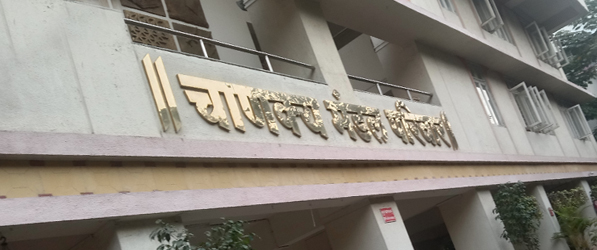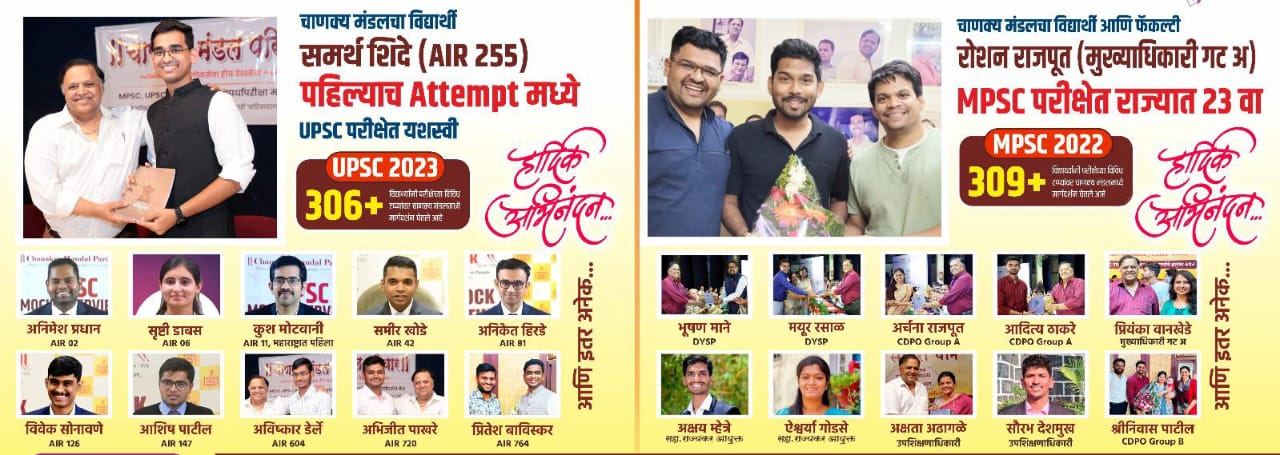Why “Chanakya”?
Arya Chanakya: Perhaps the pioneering prime bureaucrat- scholar. The thinker who realized the dangers of foreign invasion. Chanakya Mandal Pariwar has tried to awaken a corrupt exploitative, anti-people and inefficient regime. When the power-drunk corrupt regime refused to wake up, he sacrificed his career, went into wilderness organized and inspired the young generation from the commonest of the common strata of society.
He affected the political revolution which unified India and repulsed the foreign invasion. Having achieved all this he renounced all positions of power and wrote the eternal treatise ‘Artha Shastra’.
इतिहास ( प्रश्न–पत्र – I)
निर्धारित समय तीन घण्टे : अधिकतम अंक :250
प्रश्न– पत्र सम्बन्धी विशेष अनुदेश
( उत्तर देने के पूर्व निम्नलिखित निर्देशों को कृपया सावधानीपूर्वक पढ़िए)
इसमें आठ प्रश्न हैं जो दो खण्डों में विभाजित हैं तथा हिन्दी और अंग्रेजी दोनों में छपे हुए हैं।
परीक्षार्थी को कुल पाँच प्रश्नों के उत्तर देने हैं।
प्रश्न संख्या 1 और 5 अनिवार्य हैं तथा बाकी प्रश्नों में से प्रत्येक खण्ड से कम से कम एक प्रश्न चुनकर तीन प्रश्नों के उत्तर दीजिए।
प्रत्येक प्रश्न / भाग के लिए नियत अंक उसके सामने दिए गए हैं।
प्रश्नों के उत्तर उसी प्राधिकृत माध्यम में लिखे जाने चाहिए, जिसका उल्लेख आपके प्रवेश पत्र में किया गया है, और इस माध्यम का स्पष्ट उल्लेख प्रश्न सह उत्तर (क्यू० सी० ए०) पुस्तिका के मुखपृष्ठ पर निर्दिष्ट स्थान पर किया जाना चाहिए। प्राधिकृत माध्यम के अतिरिक्त अन्य किसी माध्यम में लिखे गए उत्तर पर कोई अंक नहीं मिलेंगे।
प्रश्नों की शब्द सीमा, जहाँ विनिर्दिष्ट है, का अनुसरण किया जाना चाहिए। प्रश्नों के प्रयासों की गणना क्रमानुसार की जाएगी। आंशिक रूप से दिए गए प्रश्नों के उत्तर को भी मान्यता दी जाएगी यदि उसे काटा न गया हो प्रश्न सह उत्तर पुस्तिका में खाली छोड़े गए कोई पृष्ठ अथवा पृष्ठ के भाग को पूर्णतः काट दीजिए।
HISTORY (PAPER-I)
Time Allowed: Three Hours Maximum Marks: 250
QUESTION PAPER SPECIFIC INSTRUCTIONS
Please read each of the following instructions carefully before attempting questions
There are EIGHT questions divided in two Sections and printed both in HINDI and in ENGLISH.
Candidate has to attempt FIVE questions in all.
Question Nos. 1 and 5 are compulsory and out of the remaining, THREE are to be attempted choosing at least ONE question from each Section.
The number of marks carried by a question/part is indicated against it.
Answers must be written in the medium authorized in the Admission Certificate which
must be stated clearly on the cover of this Question-cum-Answer (QCA) Booklet in the
space provided. No marks will be given for answers written in a medium other than the
authorized one.
Word limit in questions, wherever specified, should be adhered to.
Attempts of questions shall be counted in sequential order. Unless struck off, attempt of a
question shall be counted even if attempted partly. Any page or portion of the page left
blank in the Question-cum-Answer Booklet must be clearly struck off.
खण्ड – A / SECTION-A
- आपको दिए गए मानचित्र पर अंकित निम्नलिखित स्थानों की पहचान कीजिए एवं अपनी प्रश्न सह उत्तर पुस्तिका में उनमें से प्रत्येक पर लगभग 30 शब्दों की संक्षिप्त टिप्पणी लिखिए। मानचित्र पर अंकित प्रत्येक स्थान के लिए स्थान निर्धारण संकेत क्रमानुसार नीचे दिए गए हैं :
Identify the following places marked on the map supplied to you and write a short note of about 30 words on each of them in your Question-cum-Answer Booklet. Locational hints for each of the places marked on the map are given below seriatim: 50
(i) नवपाषाणकालीन स्थल
Neolithic site
(ii) माँ और शिशु की मृण्मूर्ति का स्थल
Site of Mother and Child Terracotta Figure
(iii) गुप्त मुद्रा निधि
Hoard of Gupta Coin
(iv) वानस्पतिक अवशेष स्थल
Site of Botanical remains.
(v) मिट्टी की ईंटों से बने प्लेटफार्म वाला हड़प्पा स्थल
Harappan site with mud-brick platform
(vi) मौर्य तडाग स्थल
Mauryan reservoir site
(vii) मैत्रक वंश की राजधानी
Capital of Maitraka dynasty
(viii) गोदीबाड़ा
Dockyard
(ix) शैलाश्रय
Rock shelter
(c) पत्थर की कुल्हाड़ी का कारखाना
Stone axe factory
(xi) सातवाहन अभिलेख स्थल
Satavahana inscription site
(xii) अशोक का लघु शिलालेख
Minor rock inscription of Asoka
(ciii) बौद्ध स्तूप
Buddhist Stupa
(xiv) मध्यपाषाणकालीन स्थल
Mesolithic site
(xv) लोहा गलाने की कार्यशाला
Iron smelting workshop
(xvi) महापाषाणयुगीन स्थल
Megalithic site
(xvii) सूर्य को समर्पित मंदिर स्थल
Temple site dedicated to Surya
(xviii) रोमन कारखाना स्थल
Roman factory site
(xix) मुवर कोइल (तीन मंदिर) स्थल
Site of Muvar Koil (Temple of Three)
(xxx) महापाषाण लौह स्थल
Megalith stone site
INDIA POLITICAL
- (a ) “नवपाषाण युग में हुए महत्त्वपूर्ण परिवर्तनों के कारण यह युग एक क्रांति का प्रतिनिधित्व करता है।” परीक्षण कीजिए।
“The Neolithic Age represents a revolution due to significant changes that took place during this period.” Examine. 20
(b) सिंधु–सरस्वती सांस्कृतिक क्षेत्र में एकरूपता और विविधता दोनों ही प्रदर्शित होती हैं। विवेचना कीजिए।
The Indus-Saraswati cultural zone exhibited both homogeneity and diversity. Discuss. 15
(c) भारतीय इतिहास में आर्यों की समस्या को निर्धारित करने में भाषाओं के तुलनात्मक अध्ययन, पुरातात्त्विक स्रोत और वृहद् वैदिक साहित्य कहाँ तक सहायक हैं? विवेचना कीजिए।
How do the comparative study of languages, archaeological sources and vast corpus of Vedic literature help to determine the Aryan problem in Indian history? Discuss. 15
- (a) दक्षिण भारत के प्राचीन इतिहास की सामाजिक और सांस्कृतिक परम्पराओं का ज्ञान कराने में संगम साहित्य कहाँ तक सहायक है?
How far the Sangam literature acts as a window into the social and cultural traditions of ancient South India? 20
(b) मौर्य युग में स्थापित साम्राज्यवादी विचारधारा की रूपरेखा का विश्लेषण कीजिए ।
Analyze the contours of imperial ideology as exhibited during the Mauryan period. 15
(c) पूर्वगुप्तयुगीन भारत की तुलना में गुप्त युग में महिलाओं की स्थिति का आकलन कीजिए।
Evaluate the status of women in the Gupta period as compared to the pre-Gupta era. 15
- (a) भक्ति आंदोलन के सिद्धान्तों, प्रसार और प्रभाव का मूल्यांकन कीजिए।
Analyze the tenets, spread and impact of the Bhakti Movement. 20
(b) दक्षिण भारत के आरंभिक मंदिर स्थापत्य शैली की तुलना में चोलों का मंदिर निर्माण किस हद तक और भी अधिक
परिष्कृत और भव्य दिखाई देता है ?
How far temple architecture under the Cholas became more refined and
grandiose as compared to the early South Indian temple architecture style? 15
(c) क्या यह कहना उचित है कि भारत में धार्मिक मतों के विस्तार की दृष्टि से गुप्तोत्तर काल महत्त्वपूर्ण था ?
Is it correct to say that the post-Gupta period was remarkable for the
expansion of religious cults in India? 15
खण्ड-B / SECTION – B
- निम्नलिखित प्रश्नों में से प्रत्येक का उत्तर लगभग 150 शब्दों में दीजिए: Answer the following questions in about 150 words each: 10×5-50
(a) भारतीय सामंतवाद के विभिन्न समर्थक तत्त्वों की विवेचना कीजिए।
Discuss the various proponents of Indian feudalism.
(b) अल्बेरुनी के द्वारा किए गए भारतीय समाज के आकलन के दोषों का परीक्षण कीजिए।
Examine the defects in Alberuni’s assessment of the Indian society.
(c) इतिहास के प्रमुख साक्ष्य के रूप में सूफी साहित्य के महत्त्व का आकलन कीजिए।
Discuss the importance of Sufic literature as an important source of history.
(d) दिल्ली सल्तनत के पतन हेतु आप किन कारकों को उत्तरदायी मानते हैं?
What factors do you attribute for the decline of the Delhi Sultanate?
(e) अलाउद्दीन खिलजी की कृषि नीति का उद्देश्य मध्यस्थ शक्तियों की सत्ता को नियंत्रित करना था। अपने उद्देश्य की प्राप्ति के लिए उसके द्वारा अपनाए गए उपायों का परीक्षण कीजिए।
The motive of Alauddin Khalji’s agrarian policy was to curb the powers of the intermediaries. Examine the measures which he adopted to achieve his objective..
- (a) जहाँगीर के शासनकाल में मुगल दरबार की नीतियों में नूरजहाँ की भूमिका का विवेचन कीजिए।
Discuss the role of Nur Jahan in the Mughal court politics during the reign of Jahangir. 20
(b) बलबन ने दिल्ली सल्तनत के लिए ‘विस्तारित करने‘ के स्थान पर ‘समेकित करने‘ की नीति क्यों चुनी थी?
Why did Balban prefer ‘consolidation’ over ‘expansion’ of the Delhi Sultanate? 15
(c) मुगल लघु चित्रकला में यूरोपीय चित्रकला की किन विशेषताओं का समावेश
हुआ था?
What features of European paintings were incorporated in the Mughal miniature painting? 15
- (a) मुगल साम्राज्य की अखण्डता के लिए मराठा एक महत्त्वपूर्ण खतरे की तरह खड़े थे विवेचना कीजिए।
The Marathas posed a significant threat to the integrity of the Mughal Empire. Discuss. 20
(b) ” हैदर अली साम्राज्य का निर्माण करने के लिए पैदा हुआ था और टीपू सुल्तान उसे खोने के लिए।” टिप्पणी कीजिए।
“Haidar Ali was born to build an empire, and Tipu Sultan to lose one.” Comment.. 15
(c) रंजीत सिंह के नेतृत्व में सिक्खों के उदय का विश्लेषण कीजिए।
Analyze the rise of the Sikhs under Ranjit Singh. 15
- (a) मुगल वास्तुकला की प्रकृति समन्वयवादी थी। टिप्पणी कीजिए।
Mughal architecture was syncretic in character. Comment. 20
(b) अठारहवीं शताब्दी में भारत की अर्थव्यवस्था मंद अर्थव्यवस्था नहीं थी। विवेचना कीजिए।
The economy of India was not stagnant in the eighteenth century. Discuss. 10
(c) अकबरकालीन मुगल राज्य की प्रकृति का विवेचन कीजिए।
Discuss the nature of the Mughal State under Akbar. 15
 CTS
CTS  Donate
Donate 


